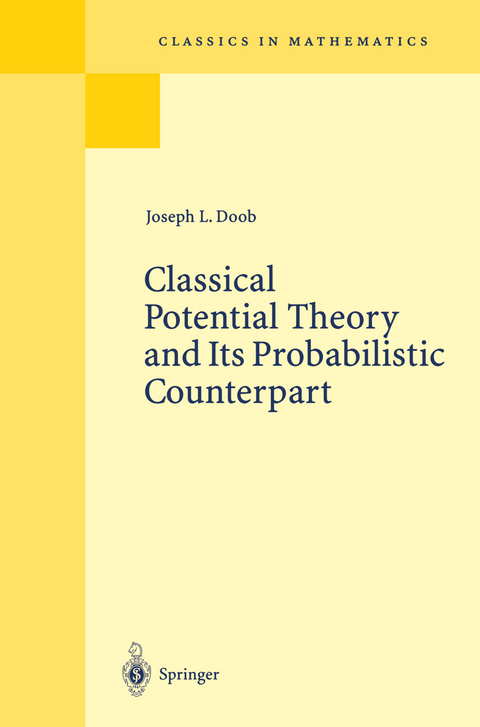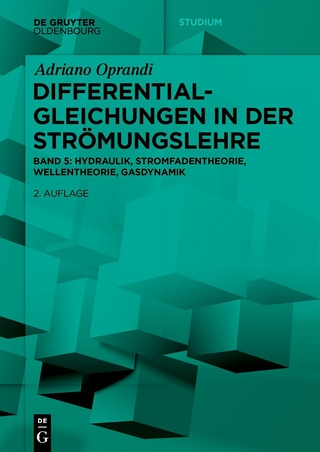
Classical Potential Theory and Its Probabilistic Counterpart
Springer Berlin (Verlag)
978-3-540-41206-9 (ISBN)
M. Brelot in Metrika (1986)
Biography of Joseph L. Doob Born in Cincinnati, Ohio on February 27, 1910, Joseph L. Doob studied for both his undergraduate and doctoral degrees at Harvard University. He was appointed to the University of Illinois in 1935 and remained there until his retirement in 1978. Doob worked first in complex variables, then moved to probability under the initial impulse of H. Hotelling, and influenced by A.N Kolmogorov's famous monograph of 1933, as well as by Paul Lévy's work. In his own book Stochastic Processes (1953), Doob established martingales as a particularly important type of stochastic process. Kakutani's treatment of the Dirichlet problem in 1944, combining complex variable theory and probability, sparked off Doob's interest in potential theory, which culminated in the present book. (For more details see: http://www.dartmouth.edu/~chance/Doob/conversation.html)
I Introduction to the Mathematical Background of Classical Potential Theory.- II Basic Properties of Harmonic, Subharmonic, and Superharmonic Functions.- III Infima of Families of Superharmonic Functions.- IV Potentials on Special Open Sets.- V Polar Sets and Their Applications.- VI The Fundamental Convergence Theorem and the Reduction Operation.- VII Green Functions.- VIII The Dirichlet Problem for Relative Harmonic Functions.- IX Lattices and Related Classes of Functions.- X The Sweeping Operation.- XI The Fine Topology.- XII The Martin Boundary.- XIII Classical Energy and Capacity.- XIV One-Dimensional Potential Theory.- XV Parabolic Potential Theory: Basic Facts.- XVI Subparabolic, Superparabolic, and Parabolic Functions on a Slab.- XVII Parabolic Potential Theory (Continued).- XVIII The Parabolic Dirichlet Problem, Sweeping, and Exceptional Sets.- XIX The Martin Boundary in the Parabolic Context.- I Fundamental Concepts of Probability.- II Optional Times and Associated Concepts.-III Elements of Martingale Theory.- IV Basic Properties of Continuous Parameter Supermartingales.- V Lattices and Related Classes of Stochastic Processes.- VI Markov Processes.- VII Brownian Motion.- VIII The Itô Integral.- IX Brownian Motion and Martingale Theory.- X Conditional Brownian Motion.- I Lattices in Classical Potential Theory and Martingale Theory.- II Brownian Motion and the PWB Method.- III Brownian Motion on the Martin Space.- Appendixes.- Appendix I.- Analytic Sets.- 1. Pavings and Algebras of Sets.- 2. Suslin Schemes.- 3. Sets Analytic over a Product Paving.- 4. Analytic Extensions versus ? Algebra Extensions of Pavings.- 7. Projections of Sets in Product Pavings.- 8. Extension of a Measurability Concept to the Analytic Operation Context.- 10. Polish Spaces.- 11. The Baire Null Space.- 12. Analytic Sets.- 13. Analytic Subsets of Polish Spaces.- Appendix II.- Capacity Theory.- 1. Choquet Capacities.- 2. Sierpinski Lemma.- 3. Choquet Capacity Theorem.- 4. Lusin's Theorem.- 5. A Fundamental Example of a Choquet Capacity.- 6. Strongly Subadditive Set Functions.- 7. Generation of a Choquet Capacity by a Positive Strongly Subadditive Set Function.- 8. Topological Precapacities.- 9. Universally Measurable Sets.- Appendix III.- Lattice Theory.- 1. Introduction.- 2. Lattice Definitions.- 3. Cones.- 4. The Specific Order Generated by a Cone.- 5. Vector Lattices.- 6. Decomposition Property of a Vector Lattice.- 7. Orthogonality in a Vector Lattice.- 8. Bands in a Vector Lattice.- 9. Projections on Bands.- 10. The Orthogonal Complement of a Set.- 11. The Band Generated by a Single Element.- 12. Order Convergence.- 13. Order Convergence on a Linearly Ordered Set.- Appendix IV.- Lattice Theoretic Concepts in Measure Theory.- 1. Lattices of Set Algebras.- 2. Measurable Spaces and Measurable Functions.- 3. Composition of Functions.- 4. The Measure Lattice of a Measurable Space.- 5. The ? Finite Measure Lattice of a Measurable Space (Notation of Section 4).- 6. TheHahn and Jordan Decompositions.- 8. Absolute Continuity and Singularity.- 9. Lattices of Measurable Functions on a Measure Space.- 10.Order Convergence of Families of Measurable Functions.- 11. Measures on Polish Spaces.- 12. Derivates of Measures.- Appendix V.- Uniform Integrability.- Appendix VI.- Kernels and Transition Functions.- 1. Kernels.- 2. Universally Measurable Extension of a Kernel.- 3. Transition Functions.- Appendix VII.- Integral Limit Theorems.- 1. An Elementary Limit Theorem.- 2. Ratio Integral Limit Theorems.- 3. A One-Dimensional Ratio Integral Limit Theorem.- 4. A Ratio Integral Limit Theorem Involving Convex Variational Derivates.- Appendix VIII.- Lower Semicontinuous Functions.- 1. The Lower Semicontinuous Smoothing of a Function.- 2. Suprema of Families of Lower Semicontinuous Functions.- 3. Choquet Topological Lemma.- Historical Notes.- 1.- 2.- 3.- Appendixes.- Notation Index.
From the reviews:
"In the early 1920's, Norbert Wiener wrote significant papers on the Dirichlet problem and on Brownian motion. Since then there has been enormous activity in potential theory and stochastic processes, in which both subjects have reached a high degree of polish and their close relation has been discovered. Here is a momumental work by Doob, one of the masters, in which Part 1 develops the potential theory associated with Laplace's equation and the heat equation, and Part 2 develops those parts (martingales and Brownian motion) of stochastic process theory which are closely related to Part 1". G.E.H. Reuter in Short Book Reviews (1985)
"This huge book written in several years by one of the few mathematicians able to do it, appears as a precise and impressive study (not very easy to read) of this bothsided question that replaces, in a coherent way, without being encyclopaedic, a large library of books and papers scattered without a uniform language. Instead of summarizing the author gives his own way of exposition with original complements. This requires no preliminary knowledge. ...The purpose which the author explains in his introduction, i.e. a deep probabilistic interpretation of potential theory and a link between two great theories, appears fullfilled in a masterly manner". Metrika (1986)
"It is good news that Doob's monumental book is now available at a very reasonable price. The impressive volume (846 pages!) is still the only book concentrating on a thorough presentation of the potential theory of the Laplace operator ... . The material in the chapters on conditional Brownian motion and Brownian motion on the Martin space cannot easily be found in that depth elsewhere. A long appendix on various topics (more than 50 pages) and many historical notes complete this great 'encyclopedia'." (Wolfhard Hansen, Zentralblatt MATH, Vol. 990 (15), 2002)
| Erscheint lt. Verlag | 12.1.2001 |
|---|---|
| Reihe/Serie | Classics in Mathematics |
| Zusatzinfo | XXIV, 846 p. |
| Verlagsort | Berlin |
| Sprache | englisch |
| Maße | 155 x 235 mm |
| Gewicht | 1262 g |
| Themenwelt | Mathematik / Informatik ► Mathematik ► Analysis |
| Mathematik / Informatik ► Mathematik ► Wahrscheinlichkeit / Kombinatorik | |
| Schlagworte | 31XX • 60J45 • Brownian motion • Markov process • Martingale • measure theory • Potentialtheorie • Potential Theory • Probabilistic Potential Theory • Stochastic process • Stochastic Processes • Uniform integrability • Wahrscheinlichkeitstheorie |
| ISBN-10 | 3-540-41206-9 / 3540412069 |
| ISBN-13 | 978-3-540-41206-9 / 9783540412069 |
| Zustand | Neuware |
| Haben Sie eine Frage zum Produkt? |
aus dem Bereich


